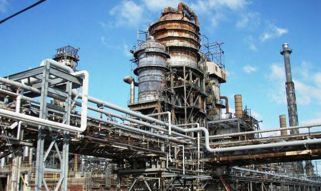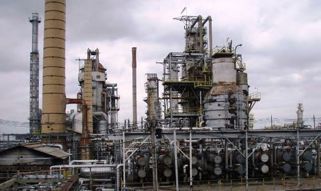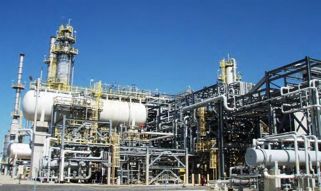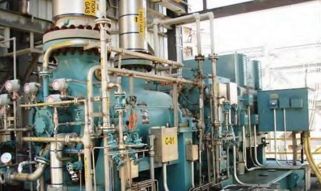Fort Saskatchewan Major Equipment Specifications
Calciners: (2)
The rotary kilns operate in a co-current configuration with the feed and process gases moving in parallel through the kiln from the feed end toward the discharge breeching. Supplemental air is injected through a lance extending into the feed end of the kiln and reacted with oil saturated catalyst charged through a feed chute from a screw feeder. The combustion of oxygen and catalyst oil raises the kiln and product temperature which drives off catalyst impurities. The off-gas sensible heat is used to heat water which will be utilized in a separate portion of the process used to extract the SO2 from the off-gas.
Kilns are 2.5 meter ID and 16 meters in length. Kilns rotate between 0.2-2.0 RPM. Maximum feed rate of spent catalyst is 907 kg/hr. Maximum temperature is 925°C. Each Kiln is equipped with an 8MM Btu burner.
Gas Cleaning
The gas cleaning system is a series of equipment designed by Bionomics Industries. The Gas Cleaning System consists of the following equipment:
Quencher, condenser/ absorber, venturi, wet electrostatic precipitators
When the gas enters the quench chamber it is adiabatically cooled by evaporation of sprayed water to a saturation temperature of ~50-65 ºC.
The condenser / absorber vessel will reserve a sufficient residence time for gas to allow growth of the fume/acid particles. The small droplets grow larger by moisture condensation on their surface. The large droplets can then be captured easier in the subsequent stages. The gas temperature is still very close to the adiabatic saturation temperature so the Condenser/Absorber is additionally required to drop the temperature of the gas to ~ 35 ºC by spraying cold liquor into the gas. This vessel is basically a direct contact packed tower.
The off-gas from the condenser / absorber vessel is routed to an adjustable pressure differential Venturi Scrubber. The scrubber knocks the particles and droplets by accelerating the gas through a venturi. Water is sprayed into the gas to improve entrainment and washing of the particles. A constant pressure drop is maintained across the venturi, regardless of the gas flowrateto attain high collection efficiency.
The final stage of gas cleaning takes place in Wet Electrostatic Precipitators (WESPs).
Very fine dust, fume and acid mist particles are collected in two inline WESPs. Particles
separated from the gas are periodically washed from the surface of collecting electrodes
by flushing water.
Quench Chamber Maximum flow Rate – 21,700 NM3/Hr @ 310°C
Condenser / Absorber Maximum Flow Rate – 26,300 NM3/Hr @ 65°C
Venturi Scrubber Maximum Flow Rate – 21,100 NM3/Hr @ 35°C
Wet Electrostatic Precipitator Flow Rate - 21,100 NM3/Hr @ 35°C, the power supply inlet is rated at 575 VAC, 3 phase, 50/60 Hz. The rated input current is 39 amps. The output voltage is 70 KVDC and the output current is 400 mADC.
Sulphur Recovery Unit:
The Sulphur recovery Unit was designed and built by Cansolv. The system consist of the following equipment: Absorber, SO2 Stripper, Re-boiler, Stripper Condenser, Heat Exchangers, Filters, and Amine Purification Unit
The gas is drawn from the wet ESP by an induced draft (ID) fan and is directed to the SO2 absorber of the Cansolv® SO2 Scrubbing System. The treated flue gas is then discharged to atmosphere through a stack that is mounted on top of the SO2 absorber. The absorbed SO2 will then be stripped from the amine in the SO2 stripper and will be sent to SO2 liquefaction unit. The Cansolv® SO2 scrubbing system is designed to treat up to 48,000 Nm3/Hr of gas originating from up to four kilns and to reduce the effluent SO2 concentration to 100 ppmv
(1) Cansolv SO2 Recovery System: Absorber, stripper, amine purif., HX's, all 316L SS.
(1) Bionomics Wet Gas Scrubbing System: Quench chamber, condenser/absorber, wet electrostatic precipitators.
(1) SO2 Liquefaction: Chiller, SO2 dryer, refrig unit, SO2 storage, loading station.
(1) Truck Unloading, Storage and Feed System: Grit Industries Auger/conveyors, 10 inch hydraulic; (3) 2260 ft3 storage silos: (3) 900 ft3 feed bins.
(2) Rotary Kilns: 9.5 x 52.5ft (2.8 x 16m), gas fired, refractory lined, Maxon burner.
(2) Screw coolers. And Dust/VOC collection system O2 and CO2 Analyzers: Rosemount model complete with gas calibration and Codel Extractive Flue Gas Analyzer model G-CEM4100.
(1) SBS system
(1) Effluent Handling: 75 ft3 (7m3) filter press, Met-Chem sludge dryer, gas fired.
(6) Aluminum Silos, 212m3 (7400 ft3), 3.6x20m (12 x 66ft), Alloy 5052.
UHF and Carbon Filters.
Miscellaneous equipment such as Plant air system, isolation and pressure safety valves, ventilation fans, Magnetic level gauges with switches
Plant Support Equipment
Trackmobile, 4150 Magnum, Diesel, 1998
Rail loading station for bulk granular material
Fork Truck, Hyster, H155FT, 15,000 lbs, b LPG, 2007
(4)Fork Trucks, Caterpillar, Hyster, Toyota, 4500-5000 lbs, LPG and electric John Deere Tractor with attachments
(2) Man Lifts, Genie Z45/22 & Accessmaster AMS-24 Floor Sweeper, Clarke, LPG
(2) Packaged Boilers B&W Type D 34,000 kg/hr@225 psi Water Chiller, Carrier 650 ton Back Up Generator, 400Kw Back Up Generators, Mitsubishi, 1000 KW and 750 KW
(6)Fluidizing Silos, Al Alloy 5052, 212m3 (12 x66 ft), Internal Air fluidizing ring
(2) Holding Silos, steel w/ epoxy lining, 236m3 (12 x71ft)
(4) Holding Silos, Steel w/ epoxy lining, 236m3 (12x71ft)
Tonne Bagging System, 20 tonnes, 10" Dia loading spout Firewater Pump, Aurora Model 411, head 288@2500 gpm, 8X10, 250HP Electric
(3) Firewater Pump, Aurora Model 411, head 288@2500 gpm, 8X10, Diesel
100 Plus pumps, blowers and Rotary Feeders
Maintenance equipment: welding machines, presses, saws, threaders and trash pumps















